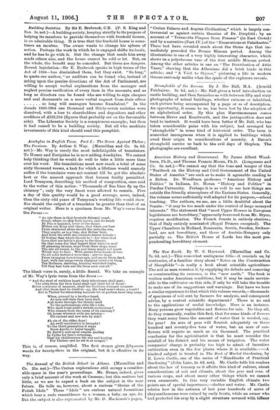The New Earth. By W. S. Harwood. (Macmillan and Co.
Is. 6d. net.)—This somewhat ambiguous title—it reminds us, by contraries, of a familiar story about "Notes on the Construction of Sheepfolds "—is really a book about scientific agriculture. The soil as man remakes it, by supplying its defects and removing or counteracting its excesses, is the "new earth." The book is written under American conditions, but it may be made service- able to the cultivator on this side, if only he will take the trouble to make use of its suggestions and warnings. But have we here a similar experience to that which this volume records,—thousands of specimens of soil sent by farmers for analysis, and consequent advice, by a central scientific department ? There is no end to the applications of useful knowledge. Here is an instance. Many persons grow vegetables and flowers for sale. Do they all, do they commonly, realise this fact, that for some kinds of flowers they want many times the amount of water that is needed, say, for peas? An acre of peas will flourish adequately on three hundred and seventy-five tons of water, but an acre of sun- flowers will require as much as six thousand. The practical conclusion for the agriculturist is that he must consider the rainfall of his district and his means of irrigation. The water companies' charge is probably too high to admit of lucrative cultivation even in the few places where it is available.—A kindred subject is treated in The Book of Market Gardening, by R. Lewis Castle, one of the series of "Handbooks of Practical Gardening" (John Lane, 2s. 6d. net). Mr. Castle tells his readers about the law of tenancy as it affects this kind of culture, about considerations of soil and climate, about the pros and cons, of various crops, and about many other things which we cannot even enumerate. In this very variable English climate two points are of special importance,—shelter and water. Mr. Castle relates how in the autumn of last year hundreds of acres of chrysanthemums were ruined by early frosts, while an owner who had protected his crop by a slight structure covered with tiffan,v
saved his flowers. In the matter of water, too, much may be done. An inch of rainfall on an acre means twenty-two thousand five hundred gallons. Of course, all water falling on buildings will be saved. Roads and paths might be cemented. The outlay would be considerable, but this would be soon repaid.



































 Previous page
Previous page